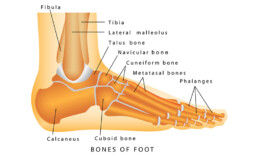If you’re a professional basketball fan you’ve undoubtedly seen one of the players on your favourite team hobbling off the court in pain, often supported by teammates or the trainer. If the player is suffering from a high ankle sprain, he could be off the court for as little as a week for a mild sprain, but the more serious version could keep him out for months. When a star player gets injured in this fashion, he may not break the ankle, but he breaks many fans’ hearts.
How Does a High Ankle Sprain Occur?
A high ankle sprain differs from the mild sprain that occurs when you roll your ankle. The ankle joint is a complex one, because it is the location where the two lower leg bones, the tibia (shin bone) and the fibula (outer leg bone), come together and join to the foot.
A high ankle sprain is an injury
- to the ligaments (connective tissue that joins two bones),
- of your sydesmosis (a fibrous joint at the juncture of the two leg bones just above the ankle bone that includes Interosseous Membrane between the two bones), and
- the anterior (front) and posterior (back) Tibio-Fibular ligaments.
It generally results from force reverberating through the ankle (e.g., when you slam it into the ground) combined with the rotational stress of turning the foot outward in relation to the leg.
Imagine two basketball players leaping for a rebound and colliding as they hit the ground, with one player’s knee knocking into the other’s. The two lower leg bones may be forced apart, the force causing the ligaments to stretch too far or tear.
It can also happen during side-to-side running, turning while in motion or stopping and starting your feet repetitively.

How Do You Know if You Have High Ankle Sprain?
Symptoms of a high ankle sprain may include:
- Minor swelling.
- Significant bruising to the inside, outside and higher portion of the ankle.
- Inability to walk.
- Severe pain.
- Pain when you try to rotate the ankle outward.
- Pain when the ankle is touched.
How Long Does It Take to Recover From a High Ankle Sprain?
When a high ankle sprain occurs, it is with one of three degrees of severity. The recommended treatment for a high ankle sprain depends on the degree of severity involved. They are slower to heal than the more common low ankle sprains. While they heal, your physician may suggest a brace, splint or cast to immobilize the ankle as it heals.
- Grade 1 sprain: This is the mildest variety of sprain with minimal damage to the ligaments, usually accompanied by pain and swelling. These milder sprains are generally treated with rest, ice, elevation and compression. Healing usually takes about six weeks, although you may not be ready to return to action immediately. You may experience joint stiffness and muscle weakness or tightness.
- Grade 2 sprain: These sprains involve extreme stretching of the ligament and may include a partial tear. There is usually significant bruising and swelling under the skin and the ankle is unstable. It generally takes 6 to 12 weeks for recovery.
- Grade 3 sprain: The most severe sprain involves a complete rupture of the ligament and walking is usually difficult. It may require surgery, especially if there is a lot of instability: your surgeon can insert a “syndesmotic screw” between the tibia and fibula to hold the bones in place while the ligament heals and is able to hold the bones in their proper positions. High ankle sprain rehab following surgery generally takes 3 to 6 months.

High Ankle Sprain Rehab
Proper recovery from a high ankle sprain includes three phases, no matter how severe the injury:
- Rest, swelling reduction and protecting the ankle.
- Restoring range of motion, flexibility and strength.
- Returning to normal activities.
Your physiotherapist will be instrumental in the recovery process, providing you with exercises and treatment that will assist you in returning to regular activities. Your physician may also suggest that you wear an ankle brace when you participate in sports.
Prevention
Unfortunately, once you experience a Grade 3 sprain, you are more prone to high ankle sprains. You can attempt to prevent further sprains by:
- Stretching properly before you exercise.
- Warming up beforehand and cooling down afterward.
- Discussing any planned new physical activities with your physiotherapist.
- When participating in high-impact sports, be conscious of your footwork.
- Stay hydrated, especially during the activity.
A high ankle sprain may put you out of action for a while, but with patience and effort, you’ll soon be back in the game.
